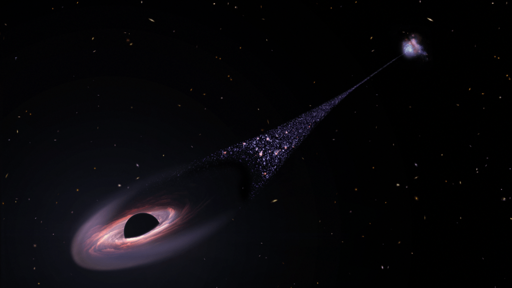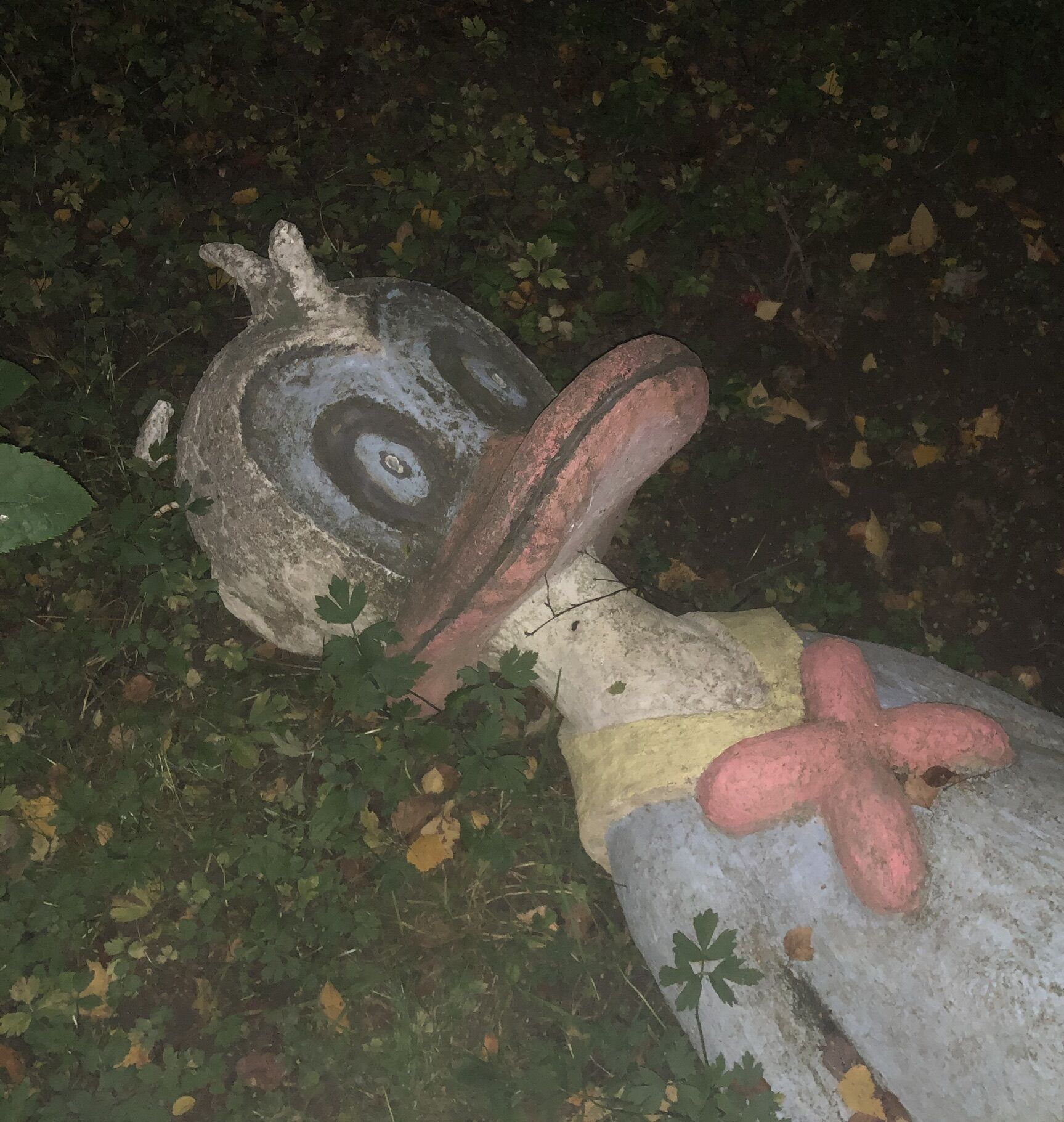There’s an invisible monster on the loose, barreling through intergalactic space so fast that if it were in our solar system, it could travel from Earth to the Moon in 14 minutes. This supermassive black hole, weighing as much as 20 million Suns, has left behind a never-before-seen 200,000-light-year-long “contrail” of newborn stars, twice the diameter of our Milky Way galaxy. It’s likely the result of a rare, bizarre game of galactic billiards among three massive black holes.
Rather than gobbling up stars ahead of it, like a cosmic Pac-Man, the speedy black hole is plowing into gas in front of it to trigger new star formation along a narrow corridor. The black hole is streaking too fast to take time for a snack. Nothing like it has ever been seen before, but it was captured accidentally by NASA’s Hubble Space Telescope.
“We think we’re seeing a wake behind the black hole where the gas cools and is able to form stars. So, we’re looking at star formation trailing the black hole,” said Pieter van Dokkum of Yale University in New Haven, Connecticut. “What we’re seeing is the aftermath. Like the wake behind a ship we’re seeing the wake behind the black hole.” The trail must have lots of new stars, given that it is almost half as bright as the host galaxy it is linked to.
The black hole lies at one end of the column, which stretches back to its parent galaxy. There is a remarkably bright knot of ionized oxygen at the outermost tip of the column. Researchers believe gas is probably being shocked and heated from the motion of the black hole hitting the gas, or it could be radiation from an accretion disk around the black hole. “Gas in front of it gets shocked because of this supersonic, very high-velocity impact of the black hole moving through the gas. How it works exactly is not really known,” said van Dokkum.
“This is pure serendipity that we stumbled across it,” van Dokkum added. He was looking for globular star clusters in a nearby dwarf galaxy. “I was just scanning through the Hubble image and then I noticed that we have a little streak. I immediately thought, ‘oh, a cosmic ray hitting the camera detector and causing a linear imaging artifact.’ When we eliminated cosmic rays we realized it was still there. It didn’t look like anything we’ve seen before.”
Because it was so weird, van Dokkum and his team did follow-up spectroscopy with the W. M. Keck Observatories
in Hawaii. He describes the star trail as “quite astonishing, very, very bright and very unusual.” This led to the conclusion that he was looking at the aftermath of a black hole flying through a halo of gas surrounding the host galaxy.
This intergalactic skyrocket is likely the result of multiple collisions of supermassive black holes. Astronomers suspect the first two galaxies merged perhaps 50 million years ago. That brought together two supermassive black holes at their centers. They whirled around each other as a binary black hole.
Then another galaxy came along with its own supermassive black hole. This follows the old idiom: “two’s company and three’s a crowd.” The three black holes mixing it up led to a chaotic and unstable configuration. One of the black holes robbed momentum from the other two black holes and got thrown out of the host galaxy. The original binary may have remained intact, or the new interloper black hole may have replaced one of the two that were in the original binary, and kicked out the previous companion.
When the single black hole took off in one direction, the binary black holes shot off in the opposite direction. There is a feature seen on the opposite side of the host galaxy that might be the runaway binary black hole. Circumstantial evidence for this is that there is no sign of an active black hole remaining at the galaxy’s core. The next step is to do follow-up observations with NASA’s James Webb Space Telescope and the Chandra X-ray Observatory to confirm the black hole explanation.
NASA’s upcoming Nancy Grace Roman Space Telescope will have a wide-angle view of the universe with Hubble’s exquisite resolution. As a survey telescope, the Roman observations might find more of these rare and improbable “star streaks” elsewhere in the universe. This may require machine learning using algorithms that are very good at finding specific weird shapes in a sea of other astronomical data, according to van Dokkum.
The research paper will be published on April 6 in The Astrophysical Journal Letters
The Hubble Space Telescope is a project of international cooperation between NASA and ESA. NASA’s Goddard Space Flight Center in Greenbelt, Maryland, manages the telescope. The Space Telescope Science Institute (STScI) in Baltimore conducts Hubble science operations. STScI is operated for NASA by the Association of Universities for Research in Astronomy, in Washington, D.C.
GOOD post
this is so fucking cool
Thanks! Sometimes the political doom-and-gloom gets a bit much. I need to remind myself that there’s an infinite universe of wonders out there. Honestly half the reason for my leftism is the hope that someday humanity will be able to devote its energies to exploring it together in peace. Maybe a bit Star-Trek-utopian but there’s nothing wrong with that as an aspiration to reach for.
 they are drifting out there
they are drifting out thereImagine being on a planet in that comparatively thin trail of stars. Your entire world’s pre-telescope cultural history all about the clouds of light that are 180° apart with some other stars and some ultra-faint other fuzzy blobs scatterred around the rest of the sky. And then telescopes are invented, and everyone is shocked to find a universe filled with star-dense self-contained galaxies, and finding out that your own world’s circumstances are not the norm ,but the exception. Imagine being a sci-fi writer on that world, themselves imagining what it would be like to live within one of those massive whirlpools of light. I wonder what stories they would write?
I also wondered if there is life on like isolated red/brown dwarf systems drifting through complete nothingness. What will they think about when they invent space travel after telescopes?
Their systems would live for 10s bln years, and yet they will be completely alone. Although we are as well, don’t think people had flights of fancies about aliens before astronomy, celestial beings sure, but not people like us around stars like ours on planets like ours
red dwarfs live for like 1 trillion years i believe
I thought they have a timeband of relatively stable thermal output (they get dimmer but very slowly) of like 10-50 billion years, and then you would have to move the planet or do some mirror shenanigans. Less of a problem than the sun enveloping earth, but not eternal
actually i think what i said might only be true for smaller red dwarfs because they are able to consume all of their fuel through convection (vs just whatever’s in the core) so they live for a very long time and are very consistent the entire time
That’s a long time when it’s cold outside and there’s no kind of atmosphere
They’re all alone. More or less.
It knows where its going
And its hungry
Hungry… for justice

coolest astronomical discovery of my lifetime thank you space lookers
oh great another potentially galaxy-rending planet-destroying stellar catastrophe i can have intrusive thoughts about constantly. i thought getting inevitably enveloped by the sun or instantly vaporized by an unlucky space beam from a quasar or something or exploded by a large asteroid was bad enough. but there’s also mobile black holes out there that we don’t even know how to look out for yet. great. cool.
I have another fun one for you then!
There’s a star not much bigger than our own sun, and only about 356 light years away, called Przybylski’s Star. That’s next-door-neighbor distance as far as cosmic scales are concerned. It has a really strange spectrum. It looks roughly sun-like, but it includes mass quantities of short lived radioactive elements. It should be impossible for a star like that to replenish them naturally. One of the wilder potential explanation is that an intelligent species is deliberately seeding their sun with elements that cannot naturally exist in it, as a deliberate signal to the universe that there is a spacefaring species there.
And if so, what is this far more advanced spacefaring species going to do when they pick up our first broadcasts in about 250 years or so?
maybe those aliens are chill, worst case scenario id still rather be vaporized intentionally by a cool alien laser than randomly by space weather








